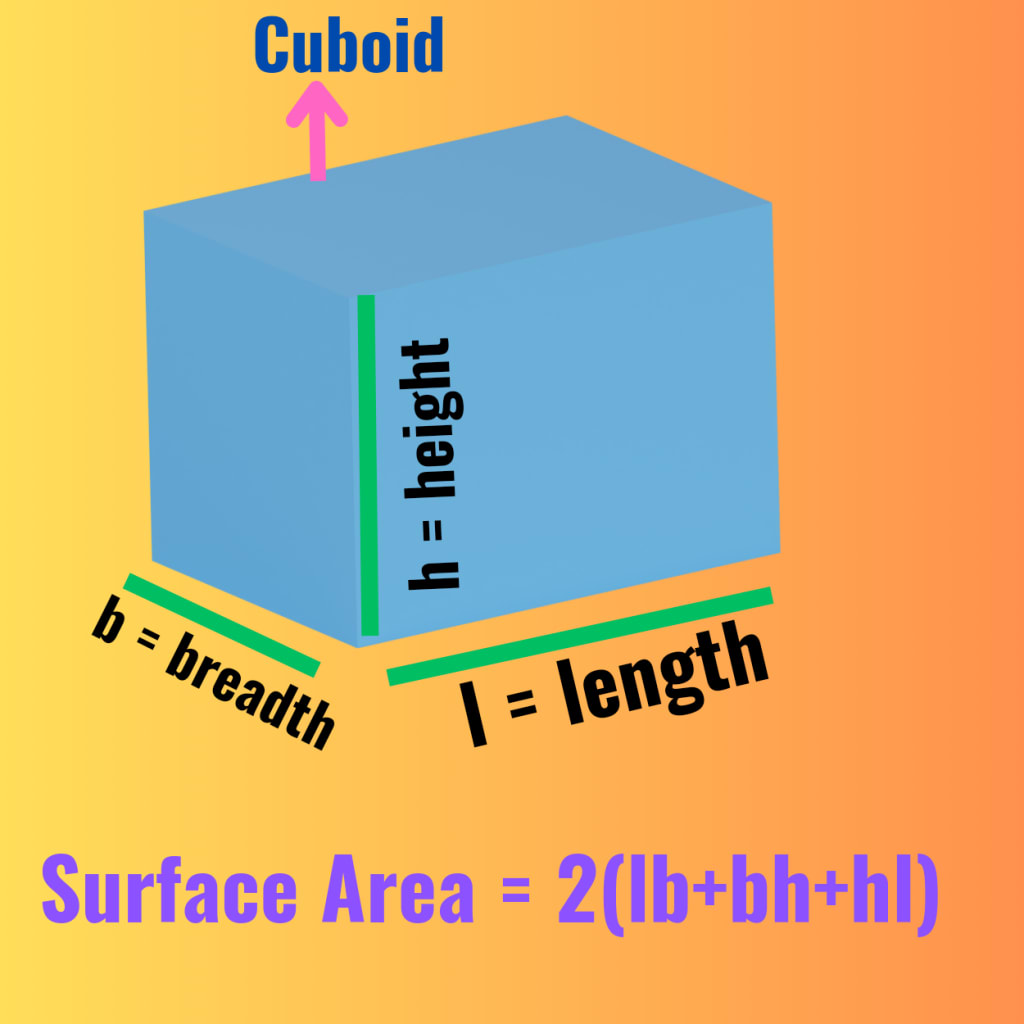Surface Area Of Cuboid
Description of surface area and its related problems of cuboid

Introduction:
The world of geometry is filled with fascinating shapes and structures, each with its unique properties and characteristics. Among these, the cuboid reflects out as a fundamental and versatile three-dimensional figure. In this article, I will explain into the intricacies of Surface Area Of Cuboid, exploring its definition, formula, and practical applications.
Explanation:
To start today’s article let’s first know
What is a Cuboid?
Defining the Cuboid:

Before we flow into the depths of Surface Area Of Cuboid, let's first establish a clear understanding of what a cuboid is. A cuboid, also known as a rectangular prism, is a three-dimensional geometric figure characterized by six rectangular faces, twelve edges, and eight vertices. These faces are arranged in pairs of opposite and equal rectangles, giving the cuboid a symmetrical and box-like appearance.
Surface Area Formula:
The surface area of any kind of three-dimensional object represents the total area covered by its external surfaces. In case of a cuboid, the surface area (SA) is calculated by summing the areas of its all six faces. Each face is a rectangle, and the area of a rectangle is given by the product of its length and width.
The formula for the Surface Area (SA) Of Cuboid
is: Surface Area of Cuboid(SA )= 2(lb + lh + bh)
Here,
l = length of the cuboid,
b =breadth of the cuboid,
and
h = height of the cuboid.
Understanding the Formula of Surface Area Of Cuboid:
The surface area formula for a cuboid may seem complex in first sight, but if we break it down into its components makes it more comprehensible and easy to memorise. Let's explore each term in the formula:
lb: This represents the area of the face formed by the length and breadth of the cuboid.If we imagine unfolding the cuboid along this face, and we'll fet a flat rectangle with dimensions l and b
lh: Similarly, this term corresponds to the area of the face formed by the length and height of the cuboid. Unfolding the cuboid along this face we will get results in a rectangular surface with dimensions l and h
bh: Finally, this term accounts for the area of the face formed by the breadth and height of the cuboid. Unfolding along this face give result a rectangle with dimensions b and h
Now If we sum up all these above three terms two times gives us the total surface area of the cuboid, which is ,
S.A = 2(lb + bh + hl)
Visualizing Surface Area:
To better understand the concept of surface area, Let us,consider a real-world analogy. Let’s Imagine wrapping a gift box with wrapping paper. The amount of wrapping paper needed to cover the entire box is akin to the surface area of the cuboid. Each face of the cuboid provides to the total amount of wrapping paper required.
Applications of Surface Area in Real Life:
Understanding the Surface Area Of Cuboid is not just a mathematical concept; it has practical implications in various real-world scenarios.
Let's explore a few applications:
(1)Packaging and Shipping:
Renoun Companies that manufacture and distribute products must calculate the surface area of packaging materials to ensure they have enough material to cover the items securely.
(2)Construction and Architecture:
Now a days most of the builders and architects use surface area calculations to estimate the amount of material needed for walls, ceilings, and floors. This is crucial for budgeting and resource planning.
(3)Painting and Wallpapering:
When we aim to paint a room or applying wallpaper, the surface area of the walls must be determined to purchase the right amount of paint or wallpaper.
(4)Carpeting and Flooring:
Just like painting, determining the surface area of floors is essential when we buy carpets or flooring materials. This ensures a seamless and aesthetically pleasing installation.
(5)Landscaping:
In outdoor projects, such as laying sod or installing artificial turf, understanding surface area helps every one in calculating the amount of material needed to cover a given area.
Example Calculations:
Let's work through a simple example to illustrate how to calculate the Surface Area Of Cuboid.
Let us,Consider a cuboid with the following dimensions:
Length (l) = 5 units
Breadth (b) = 3 units
Height (h) = 2 units
Using the surface area formula:
SA = 2(lb + lh + bh)
Substituting the given values we get,
SA=2(5×3+5×2+3×2)
=>SA = 2(15 + 10 + 6)
=>SA=2(15+10+6)
=>SA=2×31
=>SA=62
Therefore, the surface area of the given cuboid is 62units²
Now we will know
What is Lateral Surface Area Of a Cuboid?

Lateral Surface Area Of a Cuboid is the total surface area of its four walls i.e; Total area of its surrounding four fences.
Lateral Surface Area Formula of Cuboid = 2(l+b)h
Where, l = Length of the Cuboid
b = breadth of the Cuboid
h = height of the Cuboid
Some Problems related on Surface Area Of Cuboid and its area of four walls:
(i) Question: The length of a cuboid 12cm breadth 8 cm and its height is 5 cm; Find its Surface area.
Solution:
Length of the Cuboid (l) = 12cm
Breadth of the Cuboid (b) = 8cm
Height of the Cuboid (h) = 5cm
∴ Surface area of the Cuboid = 2(lb + bh + hl)
= 2( 12 × 8 + 8 × 5 + 5 × 12) [ putting values]
= 2 ( 96 + 40 + 60)
= 2 × 196
= 392 cm²
(ii) Question: Length , breadth and height of a cuboid is 10 cm, 8 cm and 3 cm respectively. Find its area iof four walls.
Solution:
Length (l) = 10 cm
Breadth (b) = 8 cm
Height (h) = 3 cm
∴ Area of four walls of the Cuboid = 2(l + b) x h
= 2 ( 10 + 8) x 3 [ putting values]
= 6 x 18
= 108 cm²
(iii)Question: Perimeter of a rectangle is 20 m and its height 5 m, find its lateral surface area
Solution:
Height (h) = 5 cm
Perimeter of rectangle = 20 m
∴ Its lateral surface area = 2(l + b) x h
= 20 x 5 [ putting values]
= 100 m²
Conclusion:
In conclusion, the Surface Area Of a Cuboid is a fundamental concept in geometry with practical applications in various fields. The formula for Surface Area Of Cuboid provides a systematic way to calculate the total external area of a cuboid based on its dimensions. Understanding this concept is essential for solving real-world problems related ......
About the Creator
Enjoyed the story? Support the Creator.
Subscribe for free to receive all their stories in your feed. You could also pledge your support or give them a one-off tip, letting them know you appreciate their work.





Comments
There are no comments for this story
Be the first to respond and start the conversation.